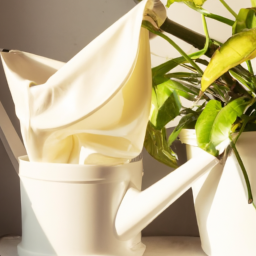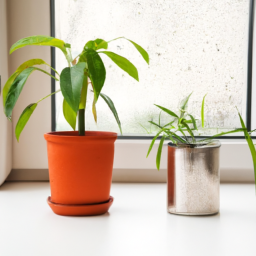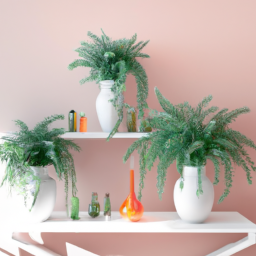
Can indoor plants cause allergies? This is a question that many plant enthusiasts and allergy sufferers often ponder. While indoor plants are known for their ability to purify the air and provide a calming ambiance, they can also be a source of allergens that trigger unpleasant symptoms. In this blog post, we will explore the potential for indoor plants to cause allergies and provide some tips on how to enjoy the benefits of indoor gardening without compromising your respiratory health. So, if you have ever wondered whether your beloved houseplants could be contributing to your allergies, keep reading to find out more.
Common Indoor Plants that Can Trigger Allergies
Many people enjoy having indoor plants as they bring beauty and freshness to their homes. However, for individuals with allergies, certain indoor plants can be a source of discomfort and allergic reactions. In this article, we will explore some common indoor plants that can trigger allergies and provide you with a step-by-step guide on how to manage these allergies effectively.
Allergy Triggers in Indoor Plants
Before we delve into specific plant types, it’s important to understand what causes allergies in indoor plants. The main culprits are pollen, mold, and dust mites. These allergens can be found on the leaves, flowers, and even in the soil of indoor plants. When released into the air, they can easily be inhaled, leading to various allergic symptoms.
Pollen is a fine powder produced by flowers and is a common allergen. It can be spread through the air or by insects. Mold spores, on the other hand, thrive in moist environments and can grow on the soil or decaying plant matter. Lastly, dust mites are tiny organisms that feed on dead skin cells and can accumulate in the soil and on the leaves of indoor plants.
Now that we understand the allergy triggers, let’s explore some common indoor plants that can cause allergies in susceptible individuals.
1. Peace Lily (Spathiphyllum)
Peace Lily is a popular indoor plant known for its elegant white flowers and glossy green leaves. However, it can be problematic for individuals with allergies. The plant’s pollen can cause allergic reactions, especially in those sensitive to pollen. Additionally, the Peace Lily is prone to accumulating dust on its leaves, which can further trigger allergies.
To minimize allergies caused by the Peace Lily, it is recommended to wipe the leaves regularly with a damp cloth to remove dust. Placing the plant in a well-ventilated area can also help reduce pollen exposure. If you are highly sensitive to pollen, you may consider choosing alternative indoor plants that have minimal pollen production.
2. Ficus (Ficus benjamina)
The Ficus, also known as the Weeping Fig, is a popular choice for indoor plants due to its attractive foliage. However, it can be a source of allergies for some individuals. The Ficus plant releases pollen that can trigger allergic reactions, particularly in those with pollen sensitivities.
To minimize allergies caused by the Ficus, it is important to regularly clean the leaves to remove dust and pollen. Consider placing the plant in a separate room or area where you spend less time to reduce exposure. If you experience severe allergies, it may be best to avoid having a Ficus plant indoors.
3. English Ivy (Hedera helix)
English Ivy is a popular trailing plant that is often used for decorative purposes indoors. While it can add a touch of greenery to your space, it can also be a potential allergen for some individuals. English Ivy produces pollen, which can cause allergic reactions in sensitive individuals.
To minimize allergies caused by English Ivy, it is important to regularly clean the leaves and keep the plant well-maintained. Consider placing it in an area with good air circulation to reduce pollen exposure. If you experience severe allergies, it may be advisable to choose alternative plants that are less likely to trigger allergic reactions.
By being aware of the potential allergy triggers in common indoor plants, you can take proactive steps to manage your allergies effectively. Regular cleaning, proper ventilation, and choosing allergy-friendly plants are key to enjoying the beauty of indoor plants without the discomfort of allergies.
Remember, if you have severe allergies or are unsure about specific plant allergies, it’s always best to consult with an allergist who can provide personalized advice and guidance.

Symptoms and Treatment of Indoor Plant Allergies
Indoor plants are a great way to bring nature into your home or office space. They not only add beauty to the surroundings but also provide numerous health benefits. However, for some individuals, indoor plants can cause allergies. In this article, we will explore the symptoms of indoor plant allergies and discuss effective treatment options.
Symptoms of Indoor Plant Allergies
Allergies to indoor plants can manifest in various ways, and the symptoms may vary from person to person. Here are some common symptoms that individuals with indoor plant allergies may experience:
1. Nasal Congestion: One of the most common symptoms of indoor plant allergies is nasal congestion. This occurs when the nasal passages become swollen and inflamed due to an allergic reaction. It can cause difficulty in breathing through the nose and may lead to a stuffy or runny nose.
2. Sneezing: Sneezing is another common symptom of indoor plant allergies. It is the body’s way of trying to expel the allergens that have entered the nasal passages. Frequent sneezing can be bothersome and disruptive to daily activities.
3. Itchy and Watery Eyes: Allergies to indoor plants can also affect the eyes. Itchy and watery eyes are common symptoms that occur due to the release of histamines in response to the allergens. Rubbing the eyes excessively can further aggravate the symptoms.
4. Skin Irritation: Some individuals may experience skin irritation when they come into contact with certain indoor plants. This can result in redness, itching, and even a rash on the exposed areas of the skin.
5. Asthma Symptoms: For individuals with asthma, exposure to indoor plant allergens can trigger asthma symptoms such as coughing, wheezing, and shortness of breath. It is essential for asthma patients to be cautious around indoor plants and seek appropriate treatment.
6. Headache and Fatigue: Allergic reactions to indoor plants can also lead to headaches and fatigue. These symptoms may occur due to the body’s immune response to the allergens, causing inflammation and affecting overall well-being.
Treatment Options
When it comes to treating indoor plant allergies, the primary approach is to minimize exposure to the allergens. Here are some effective treatment options:
1. Remove Allergic Plants: Identify the specific plants that trigger your allergies and consider removing them from your indoor space. Opt for plants with low allergenic properties, such as succulents or ferns, which are less likely to cause allergic reactions.
2. Maintain Good Indoor Air Quality: Improve the air quality in your home or office by using air purifiers or filters. These devices can help remove allergens from the air, reducing the risk of allergic reactions.
3. Regular Cleaning: Dust and allergens can accumulate on the leaves of indoor plants. Regularly wipe the leaves with a damp cloth to remove any potential allergens. It is also important to keep the surrounding areas clean and dust-free.
4. Medications: Over-the-counter antihistamines can provide temporary relief from indoor plant allergy symptoms. However, it is best to consult with a healthcare professional for personalized advice and appropriate medication options.
5. Allergy Shots: In severe cases, allergy shots or immunotherapy may be recommended. These shots help desensitize the immune system to specific allergens, reducing the severity of allergic reactions over time.
6. Consult an Allergist: If your indoor plant allergies persist or worsen, it is advisable to consult an allergist. They can conduct specific allergy tests to identify the exact triggers and provide tailored treatment plans.
Remember, while indoor plants can enhance the aesthetic appeal of your space, it is crucial to prioritize your health and well-being. By understanding the symptoms of indoor plant allergies and implementing appropriate treatment measures, you can enjoy the benefits of indoor plants without compromising your comfort.

Can Indoor Plants Cause Allergies?
Indoor plants are a wonderful addition to any home. They not only enhance the aesthetic appeal of a space but also provide numerous health benefits. However, for individuals with allergies, indoor plants can sometimes trigger allergic reactions. In this article, we will explore the topic of whether indoor plants can cause allergies and provide you with some tips for allergy-free indoor gardening.
Understanding Indoor Plant Allergies
Indoor plant allergies are primarily caused by the pollen, mold spores, or other allergens released by certain plants. These allergens can trigger allergic reactions in sensitive individuals, leading to symptoms such as sneezing, itchy eyes, nasal congestion, or even skin rashes.
It’s important to note that not all indoor plants cause allergies. Some plants are more likely to release allergens than others. Additionally, individual sensitivity to specific allergens may vary. Therefore, it’s crucial to identify the plants that may cause allergies and take appropriate measures to minimize the risk.
To determine if a particular indoor plant is causing your allergies, you can try removing it from your living space temporarily and observe if your symptoms improve. If they do, it’s likely that the plant was the culprit. However, it’s always recommended to consult with a healthcare professional for an accurate diagnosis.
Choosing Allergy-Friendly Indoor Plants
If you love indoor gardening but want to minimize the risk of allergies, selecting allergy-friendly plants is a wise choice. Here are some tips to consider:
1. Low-Pollen Plants: Opt for plants that have low pollen production. Examples include ferns, palms, snake plants, and orchids. These plants are less likely to release airborne allergens and are generally considered safe for individuals with allergies.
2. Non-Flowering Plants: Flowering plants tend to produce more pollen and can be problematic for allergy sufferers. Instead, choose non-flowering plants such as succulents or cacti, which are visually appealing and have a lower risk of triggering allergies.
3. Female Plants: Some plants have separate male and female specimens. Male plants typically produce more pollen, while female plants produce less or none at all. Opting for female plants can reduce the allergen load in your indoor environment.
Preventing Indoor Plant Allergies
Even if you choose allergy-friendly plants, it’s essential to take preventive measures to minimize the risk of indoor plant allergies. Here are some tips:
1. Regular Cleaning: Dust and allergens can accumulate on indoor plant leaves. Regularly wipe the leaves with a damp cloth or sponge to remove any potential allergens.
2. Proper Ventilation: Ensure good air circulation in your indoor space by opening windows or using fans. This helps to disperse any allergens released by the plants and maintain a healthier environment.
3. Maintain Optimal Humidity: Mold thrives in damp environments, which can exacerbate allergies. Monitor the humidity levels in your home and use a dehumidifier if necessary to prevent mold growth.
4. Consider Allergy Medication: If you’re particularly sensitive to indoor plant allergens, you may benefit from taking over-the-counter allergy medication. Consult with a healthcare professional to find the most suitable option for your specific needs.
By following these tips, you can enjoy the beauty of indoor gardening without worrying about allergies. Remember to choose allergy-friendly plants, keep your indoor space clean, and take necessary precautions to maintain a healthy environment. Happy gardening!
Key Takeaways
Indoor plants have become increasingly popular in homes and offices, as they not only add a touch of nature but also provide numerous health benefits. However, some people may wonder if these leafy companions can trigger allergies. Well, the answer is not as straightforward as one might think. While it is true that indoor plants can potentially cause allergies, it largely depends on the individual and the specific plant.
Plants release pollen, which is a common allergen. If someone is allergic to a particular type of pollen, being in close proximity to that plant could trigger their allergies. Additionally, some plants produce airborne irritants, such as mold spores or volatile organic compounds (VOCs), which can also cause allergic reactions in susceptible individuals. However, it’s important to note that not all plants release significant amounts of pollen or irritants. In fact, many indoor plants have been found to improve air quality and reduce allergens by filtering out toxins and releasing oxygen. Therefore, it’s crucial to choose the right plants and maintain a clean environment to minimize the risk of allergies.
Common Questions and Answers:
Q1: Can indoor plants cause allergies?
A1: Yes, indoor plants can potentially cause allergies in some individuals. While plants are known to improve air quality and provide numerous benefits, certain people may be sensitive to the allergens released by plants. These allergens can include pollen, mold spores, or even the sap of certain plants. It’s important to note that not everyone will experience allergies from indoor plants, and the severity of the reactions can vary.
Q2: What are the common symptoms of plant allergies?
A2: The symptoms of plant allergies can vary from person to person. Common symptoms include sneezing, runny or stuffy nose, itchy or watery eyes, coughing, wheezing, and skin irritation. Some individuals may also experience headaches or fatigue. If you suspect that your indoor plants are causing allergies, it’s best to consult with a healthcare professional for proper evaluation and advice.
Q3: Which indoor plants are more likely to trigger allergies?
A3: Certain indoor plants are more likely to trigger allergies compared to others. Plants that produce large amounts of pollen, such as flowering plants like roses, lilies, and daisies, can potentially cause allergic reactions. Additionally, plants that release mold spores, such as damp soil or decaying leaves, can also be problematic for individuals with allergies. However, it’s important to remember that not everyone will react to the same plants, and sensitivities can vary.
Q4: How can I reduce the risk of allergies from indoor plants?
A4: To reduce the risk of allergies from indoor plants, you can take several measures. Firstly, choose plants with low pollen production or opt for plants that are less likely to trigger allergies, such as ferns, palms, or succulents. Regularly dust and clean the leaves of your indoor plants to remove any potential allergens. Avoid overwatering your plants to prevent the growth of mold. Lastly, if you have severe allergies, you may consider keeping plants in well-ventilated areas or using air purifiers to filter out allergens.
Q5: Can I still enjoy indoor plants if I have allergies?
A5: Yes, having allergies doesn’t necessarily mean you can’t enjoy indoor plants. By choosing plants with low allergenic potential, maintaining good plant hygiene, and taking necessary precautions, you can still have a thriving indoor garden without triggering your allergies. It’s important to identify the specific plants or allergens that cause your reactions and adjust your plant choices accordingly. Consulting with an allergist or healthcare professional can provide further guidance and help you find suitable indoor plants that won’t exacerbate your allergies.
Dr. Olivia Green is a botanist with over two decades of experience in indoor plant cultivation. She holds a Ph.D. in Plant Biology and has dedicated her career to researching plant behavior in controlled environments. Dr. Green is passionate about helping plant enthusiasts master the art of indoor gardening through her extensive knowledge and practical insights.


